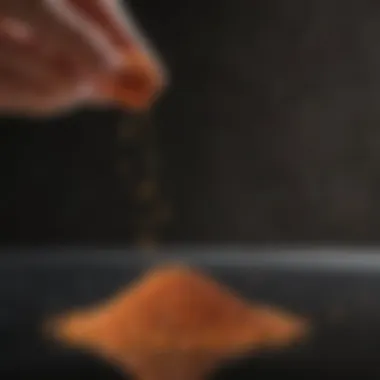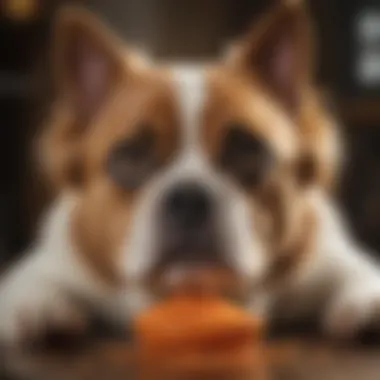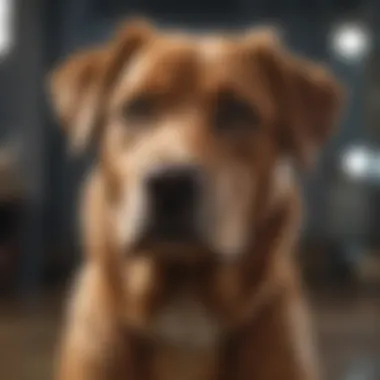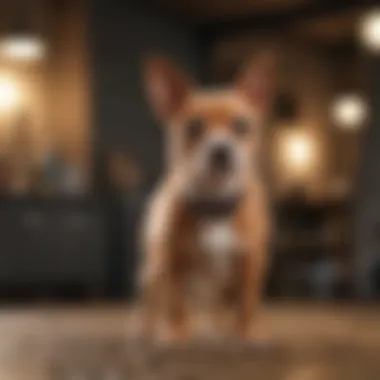Evaluating the Safety of Noxall Granules for Pets


Intro
In this article, we will delve into various aspects related to Noxall granules, providing insights grounded in both scientific research and anecdotal evidence. By covering these topics, we hope to equip pet owners with essential information that supports a safe living environment while managing pest-related issues effectively.
Chemical Composition of Noxall Granules
Noxall granules contain specific active ingredients designed to target various pests. Understanding these chemicals is crucial for evaluating their safety. Noxall primarily consists of Deltamethrin and other components that work synergistically to repel or eliminate unwanted insects.
The chemical structure of these substances can pose varying risks to different pets. For instance, while dogs may have a lower sensitivity to some of these chemicals, cats may react more adversely. Adverse reactions can include vomiting, diarrhea, or more severe neurological symptoms.
Potential Risks to Pets
Using Noxall granules can introduce risks into your home environment. Several potential hazards include:
- Ingestion of granules by curious pets.
- Direct surface contact with paws or fur.
- Exposure to dust or vapors during application.
"Understanding how Noxall affects pets is critical in avoiding potential health issues."
It is essential for pet owners to observe their pets closely after using these granules, noting any unusual behavior or health concerns. If any signs of distress occur, immediate veterinary consultation is advisable.
Guidelines for Usage in Pet-Friendly Environments
To ensure the safe use of Noxall granules, consider implementing the following practices:
- Read and follow the label instructions thoroughly. Ensure you adhere to the recommended dosage and methods for application.
- Restrict pet access during and immediately after application. Allow a safe period for the granules to settle and for any harmful vapors to dissipate.
- Post-application cleaning. Vacuum any leftover granules or dust thoroughly from areas where pets frequent.
- Consider alternative methods. If you face persistent pest issues, investigate other pest control options that may be safer for your pets.
By following these guidelines, pet owners can minimize risk while still addressing pest concerns around their homes.
Recommendations for Pet Owners
Overall, maintaining a balance between effective pest control and pet safety is essential. Here are key recommendations for pet owners regarding Noxall granules:
- Stay informed. Keep up with the latest research regarding pet safety and pest control products.
- Consult professionals. If unsure about the suitability of Noxall granules for your home, reach out to a veterinarian or pest control expert.
- Monitor pet behavior. Changes in appetite, energy levels, or bathroom habits may indicate a reaction to Noxall.
Ultimately, being proactive and knowledgeable can help in making informed decisions about pest control products used in homes with pets.
Prolusion to Noxall Granules
Understanding Noxall granules is crucial for pet owners who want to maintain a safe home environment. The product serves multiple purposes, particularly in pest control. However, the safety of its application around pets must be examined thoroughly. This section provides a foundational overview of Noxall granules, outlining what they are and how they function.
What Are Noxall Granules?
Noxall granules are a type of pest control product designed to eliminate unwanted insects and pests in household environments. Comprised of specific chemical compounds, these granules are often utilized in gardens and residential areas to keep pests at bay. The granules operate effectively by luring pests and delivering potent extermination without reliance on fluids. Their form makes them easy to apply, whether by spreading them across the intended area or mixing them into soil.
While they are advertised as safe for outdoor use, the implications for household pets can vary significantly. Pet owners must recognize that exposure to Noxall can lead to adverse reactions in animals, and therefore understanding the implications of its use in pet-friendly spaces is critical.
Common Uses of Noxall Granules
Noxall granules are primarily used for pest control in various settings. Common applications include:
- Gardens and Lawns: They help in managing pests that can damage plants or lawns.
- Indoor Spaces: Used sparingly, they can be effective in controlling pests in basements or similar areas.
- Outdoor Open Areas: Parks, patios, and other outdoor spaces often utilize these granules to maintain pest-free environments.
It's essential for pet owners to be aware that while these granules are effective against pests, their presence can pose risks to pets, especially if pets are prone to chewing or sniffing. The balance between effective pest control and maintaining a safe environment for pets hinges on informed usage of such products.
"Safety and effectiveness should coexist in pest control strategies. Understanding your products mitigates risks to loved ones."


By considering what Noxall granules are and their common uses, pet owners can begin to evaluate their impact on pet safety and adjust their pest control methods accordingly.
Understanding the Ingredients
When it comes to ensuring the safety of Noxall granules in a pet-friendly household, a profound understanding of the ingredients becomes essential. Knowledge of what these granules contain allows pet owners to make informed decisions regarding their use. By delving into the chemical composition and the potential toxicity that arises from these ingredients, pet owners can better navigate the risks involved in using Noxall granules.
Chemical Composition
Noxall granules consist of a blend of various chemical compounds that work together to eliminate pests. Knowing these components is essential because certain chemicals may be harmful or even fatal to pets, depending on their type and concentration. Typically, these granules contain active ingredients such as pyrethrins or boric acid, both of which are known for their efficacy in pest control.
- Pyrethrins: These are natural insecticides derived from chrysanthemum flowers. Despite being widely regarded as safe for humans and the environment, they can cause adverse effects in pets, especially in cats, which metabolize substances differently.
- Boric Acid: Commonly used as an insecticide, it poses risks if ingested or if a pet makes contact with treated surfaces shortly after application.
An understanding of these ingredients can empower pet owners to determine when and how to apply these granules safely. It also indicates the need for vigilance regarding how these chemicals interact with the specific biological makeup of pets.
Toxicity Levels in Pets
The toxicological profile of Noxall granules must be carefully considered. Different pets exhibit varying levels of sensitivity to the ingredients found within. For instance, certain breeds of dogs may show more tolerance, while others, particularly some cats and small animals, may experience severe toxicity even at minimal exposure.
It is important to understand potential toxicity levels, which can vary based on factors such as:
- Species: Cats are generally more vulnerable to certain insecticides.
- Weight: Smaller pets often face increased risk due to their lower body mass.
- Health Status: Pets with pre-existing health issues may react differently to these chemicals.
Research indicates that symptoms of toxicity can include:
- Vomiting
- Diarrhea
- Tremors
- Lethargy
Always consult a veterinarian when using any products containing chemicals that may affect your pets. The safety of your animal should be the top priority.
Before using Noxall granules, assess their appropriateness for your specific household situation. Understanding both the ingredients and their potential toxicity contributes significantly to creating a safe environment for your pets.
Pet Exposure Risks
Understanding pet exposure risks is critical in evaluating the safety of Noxall granules for pets. This section delves into how different exposure types can affect animal health. Both pet owners and pest control professionals must be aware of which factors contribute to risks. Knowing about exposure can help in implementing effective pest control measures while maintaining a safe environment for pets.
Direct vs. Indirect Exposure
Direct exposure occurs when pets come into contact with Noxall granules. This can happen when they walk over treated areas or play in those spots. Ingesting the granules is another form of direct exposure. Pets, curious by nature, might lick or eat granules because of their attractive smell or flavor. This can lead to immediate health consequences. Providing awareness about how to prevent direct contact is essential for pet owners.
Indirect exposure involves pets being affected without direct contact. For example, if a pet is in an area where the granules were used, they may inhale particles or have residue on their fur. This is equally concerning as it can lead to exposure over time, increasing the risk of health issues. Pet owners should ensure proper application techniques to minimize any airborne particles.
Species-Specific Sensitivities
Dogs
Dogs are often considered companions and are commonly present in many households. They have sensitive stomachs, making them more susceptible to poisoning from ingested granules. The key characteristic of dogs is their inquisitive nature. This can lead them to explore areas treated with Noxall granules, increasing the risk of ingestion. The unique feature of dogs is their tendency to sniff and taste new substances. This can be an advantage when monitoring for toxic substances, but can also mean an increased risk of exposure. Owners should be vigilant about monitoring their dogs, especially after applying pest control products.
Cats
Cats are more independent than dogs and might roam areas where Noxall granules were applied without direct supervision. Their grooming habits also present a risk, as they may ingest granule particles while cleaning themselves. A notable trait of cats is their sensitivity to certain chemicals, which can lead to severe reactions. In highlighting their unique behavior, it is crucial for pet owners to consider that even trace exposure can have profound effects on their health. Ensuring cats are kept away from treated areas is an important preventive measure.
Small Animals
Small animals, such as rabbits or guinea pigs, are often kept as pets and typically have a very different physiology compared to dogs or cats. These animals can be particularly vulnerable to toxic substances. The key characteristic of small animals is their higher metabolic rates, which can lead to faster absorption of chemicals. This means that even a small amount of Noxall can have significant effects. Careful attention must be paid to their living conditions. Keeping small animals away from treated environments is essential to prevent accidental poisoning. This is a crucial consideration when discussing the safe use of chemical pest control solutions.
Symptoms of Noxall Granule Poisoning in Pets


Understanding the symptoms of Noxall granule poisoning in pets is crucial for early detection and intervention. Pets may not exhibit obvious changes immediately after exposure. Learning to identify these symptoms can prevent possible severe outcomes and enhance the well-being of pets. This section will detail symptoms to watch for, grouped into common and severe categories.
Common Symptoms to Watch For
Common symptoms of poisoning often present differently in various pets. Here are the signs pet owners should monitor:
- Lethargy: Pets may seem unusually tired or inactive.
- Vomiting: Repeated episodes of vomiting may indicate toxicity.
- Diarrhea: Loose stool or watery feces is often a sign of gastrointestinal distress.
- Loss of Appetite: A sudden decrease in food intake can be a red flag.
- Excessive Salivation: Pets may drool more than usual due to nausea.
- Behavioral Changes: Altered behavior such as increased aggression or withdrawal can be notable.
- Difficulty Breathing: Labored breathing or coughing may occur, signaling distress.
It is worth noting that these symptoms can also stem from other health issues. However, if they coincide with Noxall exposure, it is vital to seek veterinary care promptly.
Severe Symptoms and Medical Advice
In addition to the common symptoms mentioned, pets may exhibit severe signs that require immediate medical attention. These include:
- Seizures: Uncontrolled shaking or convulsions can indicate a critical condition.
- Tremors: Shakiness or muscle tremors are alarming symptoms.
- Collapse or Unconsciousness: Loss of consciousness is a life-threatening situation.
- Severe Abdominal Pain: Pets may show signs of distress, such as whining or hiding.
If any severe symptoms occur, contact a veterinarian immediately. Prompt treatment is essential.
A pet's survival can hinge on swift actions taken by pet owners. Keeping an emergency veterinarian's contact handy is advisable. Knowing the exact amount of Noxall exposure and the timeframe since ingestion can assist veterinarians in providing the necessary treatment. Always err on the side of caution; when in doubt, seek professional advice.
In summary, recognizing symptoms of Noxall granule poisoning is essential for pet owners. Being alert to both common and severe indicators can protect pets from potential harm and guide timely veterinary intervention.
Usage Guidelines for Pet Owners
Understanding how to use Noxall granules safely is essential for pet owners who wish to maintain a healthy environment for their furry companions. The proper application and storage of these granules can significantly reduce the risk of accidents and exposure to potentially harmful chemicals. Clear guidelines help pet owners make informed decisions that ensure the wellbeing of their pets while still being effective in pest control.
Application Techniques
When applying Noxall granules, careful consideration is necessary to avoid unintended contact with pets. Here are some important application techniques:
- Timing: Apply the granules when pets are not in the vicinity. This includes waiting for them to be indoors or in another designated area during the application.
- Method: Spread the granules uniformly over the target area. For effective pest control without excessive use, consider using a spreader that allows for controlled dispensing.
- Post-application Care: After application, ensure that pets do not access the area for a specific time as indicated in the product instructions. This method minimizes their exposure significantly.
It is crucial to always read and follow the manufacturer's guidelines to determine the most effective and safe application techniques.
Safe Storage Practices
Proper storage of Noxall granules is as critical as their application. Mismanagement in storage can lead to accidents that compromise pet safety. Here are several safe storage practices:
- Secure Location: Store the granules in a secured cabinet or area that is inaccessible to pets. Consider using child-proof locks if needed.
- Original Container: Keep the granules in their original packaging with labels intact. This not only ensures the pet owner can easily refer to the safety information but also prevents confusion with other household substances.
- Temperature Control: Store granules in a cool, dry place. Extreme temperatures can affect the efficacy of the product and increase potential hazards.
By incorporating these guidelines into their routine, pet owners can better protect their animals from the dangers associated with Noxall granules while effectively managing pests.
Always prioritize the health and safety of your pets in any pest control measures.
Alternatives to Noxall Granules
When it comes to pest control in homes with pets, the importance of exploring alternatives to Noxall Granules cannot be overstated. The inherent risks associated with Noxall granules, including toxicity and exposure dangers, necessitate a careful evaluation of safer options. Understanding various alternatives can empower pet owners to maintain a pet-friendly environment while effectively managing pest issues.
Non-Toxic Pest Control Solutions
Non-toxic pest control solutions are becoming increasingly popular among pet owners who are concerned about the safety of their furry companions. These methods prioritize the health of pets while still addressing pest problems effectively. Here are a few noteworthy options:
- Diatomaceous Earth: This naturally occurring powder is effective against a range of insects. It works by dehydrating and damaging the exoskeletons of pests upon contact, making it a safe choice for homes with pets.
- Essential Oils: Certain essential oils, such as peppermint and tea tree oil, serve as natural repellents for various insects. However, pet owners must note the potential sensitivities of their pets to specific oils and use them cautiously.
- Neem Oil: Derived from the seeds of the neem tree, neem oil is an organic insecticide that disrupts the life cycle of pests. Plus, it is generally regarded as safe for pets when applied correctly.
Utilizing non-toxic pest control methods can significantly reduce the risks of adverse reactions in pets, providing pet owners peace of mind.


Integrated Pest Management (IPM) Strategies
Integrated Pest Management (IPM) strategies represent a holistic approach to pest control that minimizes the use of chemical methods, aligning perfectly with the needs of pet owners. IPM combines various pest control techniques and emphasizes preventive measures, including:
- Regular Monitoring: Observing pest activity can help in detecting problems early. This can include checking for signs of infestation in common areas where pets play or rest.
- Habitat Modification: Making necessary changes to the environment can effectively reduce pest attraction. This could mean sealing entry points around the home or keeping food stored securely.
- Cultural Controls: Implementing proper sanitation practices, such as cleaning up pet food dishes promptly, can deter pests from invading your space.
- Mechanical Controls: Using traps or barriers can assist in managing pest populations without resorting to toxic substances.
Using IPM strategies allows pet owners to adopt a more sustainable pest management plan that prioritizes the health and wellbeing of their pets while keeping pests at bay.
"Alternatives to chemical pest control not only safeguard our pets but also contribute to a healthier home environment."
Choosing to explore these alternatives helps ensure a balanced approach to pest management in homes with pets, fostering a safe and thriving living space.
Expert Opinions and Research Findings
Understanding the safety of Noxall granules for pets involves reviewing perspectives from professionals in veterinary medicine and evaluating scientific findings. Expert opinions enrich the discussion by providing clarity on the practical aspects of Noxall usage and safety guidelines. Their insights help demystify complex scientific information, ensuring that pet owners can make informed decisions based on sound advice. This section delves into both the veterinary perspectives and relevant studies regarding the safety of these granules.
Veterinary Insights
Veterinarians play a crucial role in evaluating pet health risks associated with Noxall granules. An important aspect of their insights is the awareness of specific symptoms and reactions pets may experience after exposure. Many veterinarians emphasize the need for vigilant observation after applying such products. They often recommend consulting with a veterinarian immediately if any symptoms, even minor ones, manifest.
Moreover, vets highlight the variable sensitivity among different species. Dogs might react differently than cats or small animals. Understanding these nuances is essential. One veterinarian stated, "Knowing how your pet reacts to different substances is crucial. Some pets may have sensitivities that can lead to severe reactions that might not be typical."
Studies on Granule Safety
Recent studies investigating Noxall granules' safety shed light on their potential effects on pets. Many published research papers conclude that while the granules can be effective against pests, they might pose risks to domestic animals. Most research focuses on toxicity levels in the context of accidental ingestion or prolonged exposure.
Research indicates that even small amounts can lead to adverse effects in pets, urging cautious application.
Studies also emphasize the need for controlled environments during application. In controlled settings, professionals observed that pets who were exposed showed fewer negative effects when granules were applied according to safe practices. This highlights the importance of following manufacturer guidelines and recommendations.
In summary, expert opinions and scientific studies provide a well-rounded view of Noxall granules' safety. They underline the importance of understanding how these granules work and their potential risks, emphasizing that responsible usage can help mitigate dangers for pets. Through the integration of professional insights and research findings, pet owners are better equipped to navigate these concerns.
Epilogue and Recommendations
Assessing the safety of Noxall granules is crucial for pet owners. Understanding how these granules interact with pets ensures that informed decisions can be made regarding pest control in pet-friendly environments. Noxall granules can offer effective pest management solutions but come with inherent risks, which is why careful consideration is necessary.
Pet owners must prioritize their animals' safety while managing pests. Choosing environmentally friendly products and strategies that mitigate danger can lead to a harmonious balance between controlling pests and protecting pets. Considering the various factors, including pet sensitivity, exposure scenarios, and application techniques, can further enhance safety.
Important elements to keep in mind include:
- Understanding the potential toxicity of ingredients in Noxall granules.
- Applying them in a way that minimizes contact with pets.
- Regularly monitoring pets for any adverse reactions.
- Utilizing alternatives when appropriate to ensure overall wellness.
By taking a proactive approach, pet owners can contribute positively to their pets' health and well-being while addressing pest issues efficaciously.
Making Informed Decisions
Making informed decisions involves thorough research and consideration of multiple factors. Pet owners should clearly understand the ingredient composition of Noxall granules, particularly any potential toxic effects. The need for maximizing safety cannot be overstated.
Here are key considerations for pet owners:
- Read labels and instructions carefully before using any product.
- Identify the specific needs of your pet, including any allergies or sensitivities.
- Consult with veterinarians or pet care professionals regarding the safety of using Noxall granules.
- Monitor pets closely after application to observe any changes in behavior or health.
This careful approach can help ensure that pet owners make choices that are conducive to both effective pest control and the safety of their beloved animals.
Resources for Ongoing Education
Ongoing education is essential for responsible pet ownership, especially regarding safety with products like Noxall granules. Pet owners should continually seek out reliable information from various sources. Here are some valuable resources:
- Pet Poison Helpline - Offers guidance on toxic substances and how to identify them.
- Wikipedia - Provides broader context on pest control methods, including chemical and non-chemical alternatives.
- Veterinary Websites - Can connect owners with professionals who have advanced knowledge on pet safety.
- Pet forums such as Reddit can provide anecdotes and shared experiences among owners regarding pest control solutions.
By utilizing these resources, pet owners can remain informed and prepared to face challenges while ensuring the health and safety of their pets.







